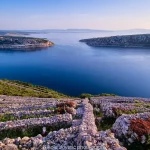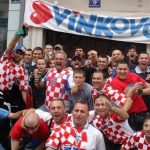Continuing our occasional series with TCN writers on November 4, 2017, looking at the best places to live in Croatia – a very subjective topic – the case for Varazdin County.
A lot of eyebrows were raised when I announced that I was moving from the idyllic island of Hvar last year, even more so when I told people where we were moving to. They thought I was nuts.
“Varazdin? From Hvar? Why?”
As I put the kids to bed on December 27 on the first night in our new home, I was beginning to have my doubts.
“The house is very nice, Daddy, but can we go back to Jelsa and Grandma?”
It was an inauspicious start. One of the things I had promised which I thought I could guarantee was plenty of snow, which is always a source of fascination for kids from sunny Hvar. And I was starting to check my sanity as we watched images of Dubrovnik cloaked in white while our lawn was a grassy shade of green. There was a feeling among the little ones that Daddy was deceiving them with these snow promises, and I was more than relieved to come out of a meeting in Zagreb a few days later to see the city covered in white, a situation I encountered all the way home until I reached our street at midnight, to be greeted by five snowmen in the front garden. You can always tell where the kids from Hvar live when the snow falls…
It is almost a year since we moved, a year which has included frequent visits to sunny Dalmatia for me with work, and Easter and summer on Hvar with the family. That is the beauty of Dalmatia – it is always there in the summer. Having spent 13 winters in Jelsa, braving the bura on a regular basis and huddling inside one of the few bars open in winter, I used to feel a little resentful of the locals returning from Zagreb just for the summer. But I have to admit that the combination of life on the mainland with summer on the island is an unbeatable combination.
So why Varazdin County in particular? What makes it so special?
Location. Starting from Jelsa, almost anywhere else in Croatia would beat it for location, in terms of trying to get to other places. As my work is more Zagreb-centric these days, my commute involved a 04:30 start and 06:00 catamaran to Split (when the bura was not blowing), a wait for an hour, then five hours on the bus to Zagreb, arriving in time for my first meeting at 14:30. A two-day trip would mean I had to be on the bus at 15:00, arriving just in time for the last ferry at 20:30 and home at 23:00. Compare with the options now – a one-hour drive to the centre of Zagreb or (my preferred option), a lift with my neighbour at 07:30 to the bus station for the 08:00 bus. First meeting starts at 10:00 and the last bus (there are plenty of earlier ones if the need arises) is at 22:10. I can have a drink and achieve more in 12 hours a week in Zagreb that I could in three weeks starting from Jelsa.
But location too, for all that is around us. Slovenia, Hungary, Austria are a short drive away. A trip to Munich took just 4.5 hours, and Budapest in under 3 hours suddenly opens up a whole world of opportunity for discovery. Coming from a culture of island living, where every excursion starts with a check of the ferry timetable and two-hour boat crossing, the options are very liberating. While we have yet to explore these fully, just knowing that they are there has a great psychological effect. And it is not just the international travel options. An hour in the car takes one to an array of interesting destinations within Croatia. Northern Croatia has some outstanding agrotourism options, for example, a chance to get the kids off their gadgets and back to nature.
Bureaucracy. Life in The Beautiful Croatia is not easy. Trying to cope with the daily grind is a test of nerves at the best of times, but when local officials take an imperfect system and add their twist of laziness and disinterestedness, one can get really frustrated. After 13 years on Hvar, I assumed that Dalmatian bureaucracy was the national standard, and it has been a revelation to encounter the Varazdin bureaucracy in action. Here is a place where everything is more or less in the same place (it is a small town), where the bank clerk will walk you to your desired destination rather than explaining how to get there, and where the man from FINA will call after you to give you the company stamp you had left on his counter. Dealing with organisations such as the police, utility companies and similar is almost pleasant. It is certainly efficient. Hell, in this part of Croatia, building permits are granted in weeks, not years (the Dalmatian way).
Mentality. When I went back to Jelsa at Easter and people asked me how it was going, I told them that one of the things I liked the most about Varazdin living was the mentality. They all nodded sagely. It is no secret that Dalmatian islanders – much as I love them – are not the most straightforward of people. Up north, people seem more aligned to the German mentality. They don’t have the luxury of tourism income from apartments on the coast, and they have to work harder for less money. As a result, the mentality is a lot more workmanlike and easier to deal with, with the Austro-Hungarian factor an obvious influence. The people and neighbours we have met have been warm, open and hospitable. I couldn’t have wished for better neighbours.
Season of tourism v seasons of nature. This might be hard to explain to someone who does not live in a tourist destination. Tourists are the lifeblood of a destination’s economy, and they are very welcome. The reality of life in a seasonal tourist destination from a local perspective is that one spends the entire winter waiting for the season, with most businesses and shops closed, and then when the season comes, everyone is too busy working to make their money for the year to be able to enjoy the destination. The contrast between the two phases gets draining over time. As a visitor, it is not noticeable or an issue, but it does have an effect. Varazdin has its tourism, not as developed as on the coast, but it is one part of the region’s makeup and does not dominate in the same way.
A different type of seasonality has been really appealing this last year – nature. While I will confess that the snow and temperatures of minus 12 were a shock to the system coming from Hvar, the reality of four full seasons has been very refreshing. As Winter gave way to Spring, and Summer to Autumn, life in Varazdin is reminiscent of my youth in northern England. It feels a lot more natural, and each season brings its own charms.
Shopping as It Once Was. Once we had got used to the convenience of a shopping centre around the corner, with lots of international brands in-house (a huge initial plus after more than a decade of island living), the real shopping experience began. The Mljekomat, a wonderful machine which dispenses fresh milk from a local producer for just 5 kuna a litre, and the introduction to the network of local producers of organic food – eggs, chicken, vegetables and more. While the supermarkets have their convenience, there is nothing to beat the availability of quality, local and organic produce. A part of our garden was turned over to cultivation, and we would compare crops with the neighbours. A wonderful opportunity to keep the kids affinity to the soil – nurtured for years in Grandpa’s field – and away from the iPads for a while.
Schools. Varazdin has a great reputation for education, and it is known for its IT excellence, both for business and university. Our nervousness as we waited for our girls at the end of the first day at school soon dissipated when two large smiles greeted us. Schools and Varazdin in general offer an excellent range of extra-curricular activity – gymnastics, guitar, swimming, art, robotics and embroidery are ones that have involved us so far.
A gorgeous, gorgeous little town. The moment I truly fell in love with Varazdin was during its most famous festival, Spancirfest, the largest street party in Croatia. A time when the stunning old town, with its narrow alleys and wonderful historic buildings truly comes to life. It is one of Croatia’s most beautiful towns, a former capital city, and one known for its culture. Spancirfest in August, Varazdin Baroque Evenings in September and October – there is always something going on. And when there is not, it is a delight to walk its old streets and take in the views and the history.
Varazdin. No Adriatic sea here to entice you, but the Adriatic – like so many other things – is very accessible. One of Croatia’s true gems, isn’t it time you planned a visit?
Want to learn more about Varazdin? 25 things to know…
Where else is great to live in Croatia? The case for Rijeka.








